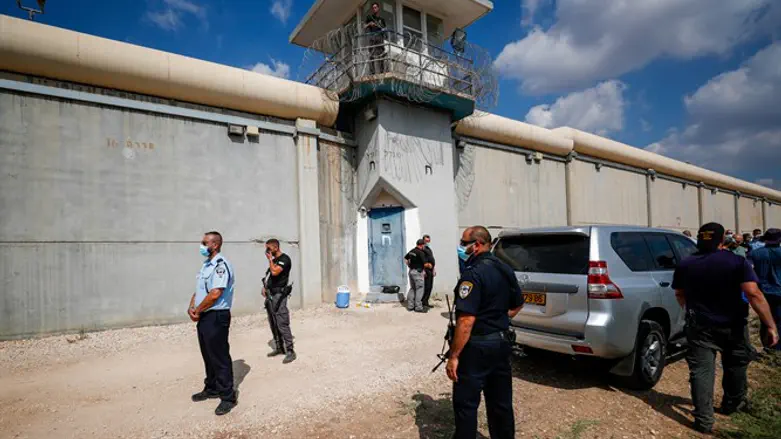
The prosecution filed indictments this morning (Sunday) in the Nazareth Magistrate's Court against the six terrorists who escaped from Gilboa Prison last month.
The terrorists are accused of escaping from legal custody, not security offenses. The maximum penalty for this offense is seven years in prison. Five other inmates at the jail were charged with aiding the terrorists who escaped. The prosecution asked the court to extend the detention of all 11 until the end of the proceedings.
The defendants who escaped are Zakaria al-Zoubeidi, Mahmoud Abdullah Ardah, Mohammad Qassem Ardah, Yaqoub Mahmoud Qadri, Ayham Kamamji, and Munadel Infeiat. The defendants who assisted in the escape but did not escape themselves are Mahmoud Abu Ashrin, Katzi Marai, Ali Abu Bakr, Mahmoud Abu Bakr and Iyad Jaradat.
The indictment alleges that at the end of 2020, Mahmoud Ardeh decided to dig a tunnel from his cell in order to escape from the prison. He addressed the defendants Qadri, Kamamji and Infeiat and offered them to take part in the excavation of the tunnel and use it to escape from the prison and they agreed to this. In March, Mohammad Ardah, Mahmoud's cousin, also joined the escape plan.
From the end of 2020 until the day of the escape, the defendants dug a tunnel whose opening was under the cell shower. Defendants removed a marble slab under the sink, dug under it and each day would put the marble slab back in place to hide the excavation. The defendants carried out the excavation work on a daily basis, in shifts adjusted to the prison itinerary, to prevent the discovery of the escape plan, while using improvised excavation tools.
To help the diggers carry out the escape plan, five other prison inmates also took part in digging the tunnel. Some also sat in the cell with the job of warning of the arrival of prison staff as well as making sure other inmates did not enter the cell. Some helped remove sandbags from the tunnel to allow the diggers to exit the cell.
Towards the end of the tunnel excavation, cousins Mahmoud and Muhammad Ardha and defendant Jaradat decided to approach Zakaria al-Zoubeidi and offer him the chance to escape from prison with them, so that al-Zoubeidi would take advantage of his status and connections in the Palestinian Authority and ensure that after the escape the escaped prisoners would receive protective detention. Al-Zoubeid agreed to the escape plan and applied to move to the Islamic Jihad cells in the prison.
On September 5, al-Zoubeidi moved to the cell, and on that day the excavation of the 30-meter-long tunnel beyond the prison walls was completed. That night, the six defendants fled through the tunnel, equipped with a change of clothes, food, and radios to monitor the progress of the search and the location of the security forces. The escape of the prisoners was discovered about an hour and a half later, at which time extensive searches began to locate them began.
The six fugitives arrived in the village of Na'ura, when Mahmoud Ardeh asked his brother to come with a vehicle to flee to the Palestinian Authority. The escapees decided to split up into pairs to make it harder for them to locate. Eventually, all six were caught within a week of the escape.
A preliminary report into the intelligence failure which led to the escape by six terrorists from the Gilboa Prison found that the terrorists likely crumbled the concrete on the floor of the cell using acid or Coca-Cola. Kan 11 News reported.
The terrorists dug 29 meters (about 100 feet) of tunnel.
The report commissioned by the Israel Prison Service (IPS) also shows that the escape route of the prisoners included lifting a marble slab in the shower cubicle and digging a tunnel shaft through layers of steel and concrete to the space below.
On the question of how the terrorists dug in the concrete, the IDF unit of the IDF unit writes that "concrete can be weakened and crumbled over time by using various acids, without the use of special means, a cola drink can be used. The metal netting can be cut with the help of an improvised nail file over time."
The report details how the terrorists got to the space under the cell: "The prisoners' escape route included digging a tunnel shaft under a marble slab in the shower cubicle, passing through the top tin (5 mm of steel) and through the ground floor (20 cm of concrete) into the underground space."
The report reveals that the terrorists were forced to dig 29 meters underground: "The length of the escape tunnel is about 35 meters, w29 meters of which they dug themselves, with an average diameter of 0.5 meters, ie an amount of 5-6 cubic meters of soil. The excavation material was used to line the excavated route inside the spaces of the link beams, saving the need to evacuate the excavation material into the prison."